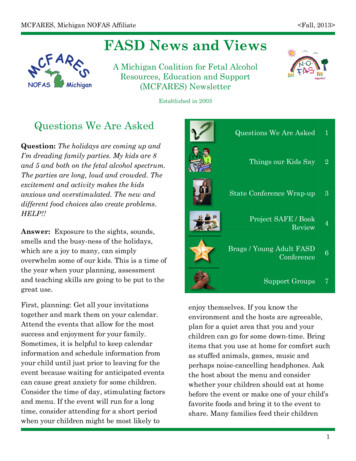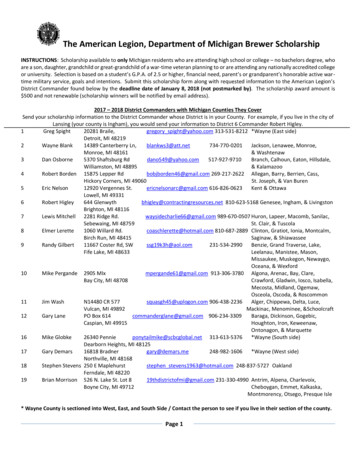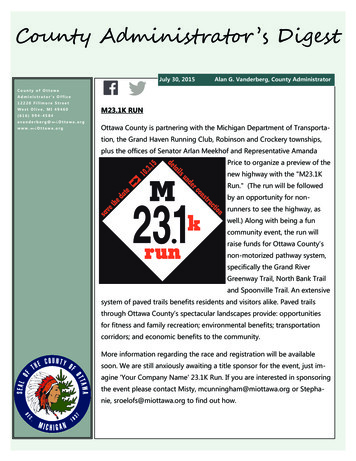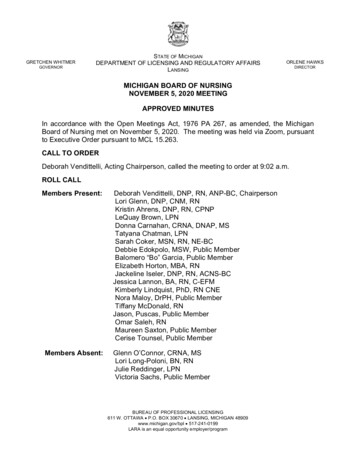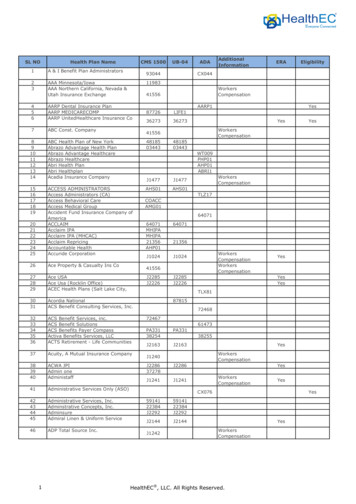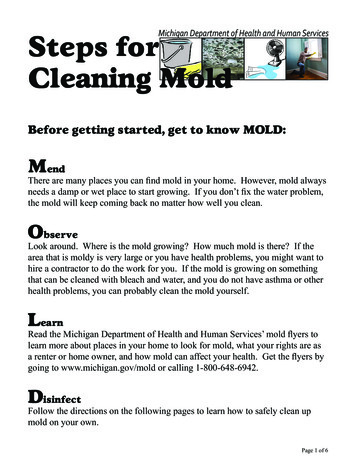
Transcription
Michigan Department of Health and Human ServicesSteps forCleaning MoldBefore getting started, get to know MOLD:MendThere are many places you can find mold in your home. However, mold alwaysneeds a damp or wet place to start growing. If you don’t fix the water problem,the mold will keep coming back no matter how well you clean.ObserveLook around. Where is the mold growing? How much mold is there? If thearea that is moldy is very large or you have health problems, you might want tohire a contractor to do the work for you. If the mold is growing on somethingthat can be cleaned with bleach and water, and you do not have asthma or otherhealth problems, you can probably clean the mold yourself.LearnRead the Michigan Department of Health and Human Services’ mold flyers tolearn more about places in your home to look for mold, what your rights are asa renter or home owner, and how mold can affect your health. Get the flyers bygoing to www.michigan.gov/mold or calling 1-800-648-6942.DisinfectFollow the directions on the following pages to learn how to safely clean upmold on your own.Page 1 of 6
Mold Cleaning KitThings you will need:long rubber glovesgoggles(like dishwashing gloves)a measuring cup(without holes or air vents)two buckets(1 gallon size or larger)2 sponges or ragsN-95 mask(you can buy at a localhome improvement store)waterhousehold bleach*(do not use pool bleach)DIRECTIONS1. Open windows, if possible.Make sure you have a lot of fresh air. If you can’t open windows, usefans to blow clean air from other rooms.2. Put on your gloves, goggles, and face mask.3. Make your Mold Cleaning Mix. Mix 1 cup of bleach with 1 gallon of water in one bucket. Stir up the bleach and water with your gloved hand, being careful not to splash. Add one sponge or rag to the bucket.4. Fill the second bucket with water only and add the other sponge or rag.Be very careful to keep the Mold Cleaning Mix away from kids and pets.NEVER MIX BLEACH AND AMMONIA.*If you or others in your home have asthma, you should not use bleach. Please contact theMichigan Department of Health and Human Services at 1-800-648-6942 for other cleaning options.Page 2 of 6
Getting Ready to CleanSort everything that is moldy into two groups:Things that water CAN’T soak into:linoleum floorsstovessinksplastic toystile wallsmetaland more.Things that water CAN soak into:carpetcouchesstuffed animalsclotheswooddrywalland more.DIRECTIONSto clean things that water CAN'T soak into1. Put together your Mold Cleaning Kit.2. Apply the Mold Cleaning Mix.Wipe the mix onto the things that are moldy using your sponge or rag. Ifthe items are small enough, you can soak them directly in your bucket ofMold Cleaning Mix.3. Let the items sit or soak for 10-15 minutes.4. After 10-15 minutes, rinse the things using plain water.5. Dry everything very well.Use towels or fans to blow on the things and area you cleaned.6. Repeat if necessary.You may need to do steps 2-5 again if the mold is still there.7. If the mold still cannot be removed, you should consider throwing the items away.Remember that the bleach might discolor some items,so test the Mold Cleaning Mix on a hidden area beforeusing it on the entire item.Bleach should not be used on metal objects. For theseitems, wipe the mold off with a mix of warm water anddish soap.Page 3 of 6
DIRECTIONSto clean things that water CAN soak intoSmall ThingsIf the item is small enough that it can fit in a washing machine andcan be safely washed, try washing it on a HOT water cycle with yourregular laundry soap.Dry everything very well.Do the items still smell like mold or dirt?Can you still see the mold?If so, you should throw it away. If not, it should be OK to keep it.Big ThingsHas everything been wet for two days or MORE?If you answered yes, you will probably need to throw thoseitems away. This includes carpet and couches. Mold isalready growing, even if you can’t see it yet, and couldcause health problems later.Has everything been wet for LESS than two days?As long as you don’t see any mold growing already, try to soak up as much water as youcan with towels or a wet/dry vacuum (like a Shop-Vac, for example).Open your windows or turn on your air conditioning or heat blowers toget fresh air moving through the area where the wet things are found. Ifyou have a fan, use it to blow fresh air directly on the wet area.You need to dry everything as fast as possible.Page 4 of 6
Wood and DrywallWhile wood and drywall feel hard, water can still soak into it.This means mold could be growing inside your walls whereyou can’t see it.If there is a lot of mold on your walls or ceiling, the BESTthing to do is to cut it out and replace the section.You might want to hire a home contractor to do this, especiallyif the mold has grown on the wood and support beams insidethe wall.Removing the wood or drywall is the only way to be totallysure you get rid of all of the mold. However, if you prefer totry cleaning it, see page 6 for instructions.About hiring a home contractorIf you decide to hire someone to remove and repair damage caused by mold, it isrecommended that you use a home repair contractor.A home repair contractor is usually cheaper than a moldremediator, or someone that only repairs homes withmold, because they do not do all the testing that moldremediators do. Testing for mold is not needed andonly adds to your cost.A regular home repair contractor is capable of cleaningand repairing your home after a problem with mold.Note that the State of Michigan does not license or certify companies for mold clean-up.mold on a wallmold inside a cabinetmold on a wall and carpetPage 5 of 6
Cleaning the wood or drywall yourselfIf the area that is moldy is small (the US Environmental Protection Agency suggests anarea smaller than 3 feet by 3 feet), and you do not want to cut it out of the wall, you canfirst try to clean the wood or drywall yourself with the Mold Cleaning Mix (see directionson page 2). If the mold comes back again after you try to clean it, then you will need to cutout the drywall.DIRECTIONS1. Put together your Mold Cleaning Kit.2. Wipe on the Mold Cleaning Mix.Wipe the Mold Cleaning Mix onto the wood or drywall using yoursponge or rag. Remember that the bleach might discolor some items,so test it on a hidden area first.3. Let the Mold Cleaning Mix soak into the wood or drywall for 10-15minutes.4. After 10-15 minutes, wipe the wood or drywall with the plain water.5. Dry the wood or drywall well.Soak up as much water off the wood or drywall as you can with towels, and if possibleuse fans to blow on the area to dry it as quickly as possible.6. After the wall is dry, you can re-paint the area.There are special paints available that are advertised tocover mold stains. Talk to your local paint supplier tofind the paint that best meets your needs.Is more information available?Yes! Contact the Michigan Department of Health and Human Services at1-800-648-6942 or visit www.michigan.gov/mold for these other fact sheets: All About MoldMold and Your HealthMold and Renter DisputesMold and Home OwnersAll About Mold (for Health Care Providers)v. 05-2016Page 6 of 6
Steps forMichigan Department of Health and Human Services. Cleaning Mold. Before getting started, get to know MOLD: M. end There are many places you can find mold in your home. However, mold always needs a damp or wet place to start growing. If you don’t fix the water problem, the mold

